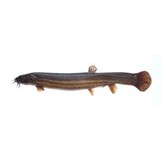The Misgurnus fossilis (European weatherfish) qPCR eDNA detection kit is able to detect the fish species Misgurnus fossilis in all waters worldwide and contains enough materials for 200 reactions. The kit is based on the fast, sensitive, and proven primers/probe qPCR technique. The kit contains primers and a probe for detecting a highly specific sequence present on the mitochondrial DNA of the species Misgurnus fossilis
Species information
Misgurnus fossilis is a species of loach in the genus Misgurnus. It is commonly known as European weatherfish or European weather loach, due to its activity patterns changing when air pressure rises or falls. If there is a sudden change in barometric pressure, the weatherfish comes to the surface and swims about excitedly. In water with a low oxygen content it gulps air; it extracts oxygen through its intestinal mucous membrane, which has a complex system of blood vessels. It feeds on thawed frozen blood worms, small fish, brine shrimp, earthworms and some vegetables. It is quite an active loach and can grow to a length of 30 cm. The distribution of the weatherfish stretches from the Seine to the Neva, and from the Danube to the Volga. It lives in still waters of muddy river meanders along the shore, and will survive in conditions which not even the most resistant of carp or tench will put up with. Because of their toleration and quick adaptation to low-oxygen and low visibility environments, they are able to become invasive species when introduced to non-native environments through the aquarium trade.
In English: European weatherfish or European weather loach.
In German: Europäische Schlammpeitzger.
In French: Loche d’étang.
In Dutch: Grote modderkruiper, weeraal.
Primer design
The qPCR primers and probe are specially designed to be used with eDNA samples and have the following properties:
- Highest possible sensitivity (<10 DNA copies per reaction). Environmental water samples contain normally very low amounts of target DNA.
- Strong fluorescence signal with low background noise. Isolated environmental samples contain residues of naturally occurring auto fluoresce substances that will interfere with the measurements. A strong fluorescence signal from the analyses is required for these kind of samples.
- 100% specificity. Isolated DNA from environmental samples contains billions of DNA fragments from bacteria, protozoa, plants, animals, etc. Not only animals from the same order (fish) must be taken in account during primer/probe design, but all known DNA sequences must be checked for nonspecific binding of the primers and probe. This is validated by experimental and bioinformatical studies.
The kit is developed and optimized to be used on eDNA isolates purified using the eDNA isolation kit (#SYL002) from Sylphium molecular ecology.
Kit contentsThe kit contains materials for 200 reactions.
- Positive control (Misgurnus fossilis DNA)
- 2x Sylphium qPCR mix (100 reactions) without primers and probes
- 2x Primer/probe mix (100 reactions) for detection of Misgurnus fossilis (FAM dye)
- 1x Taq DNA polymerase (200 reactions)
- Protocol and primer/probe validation report
Manual




















